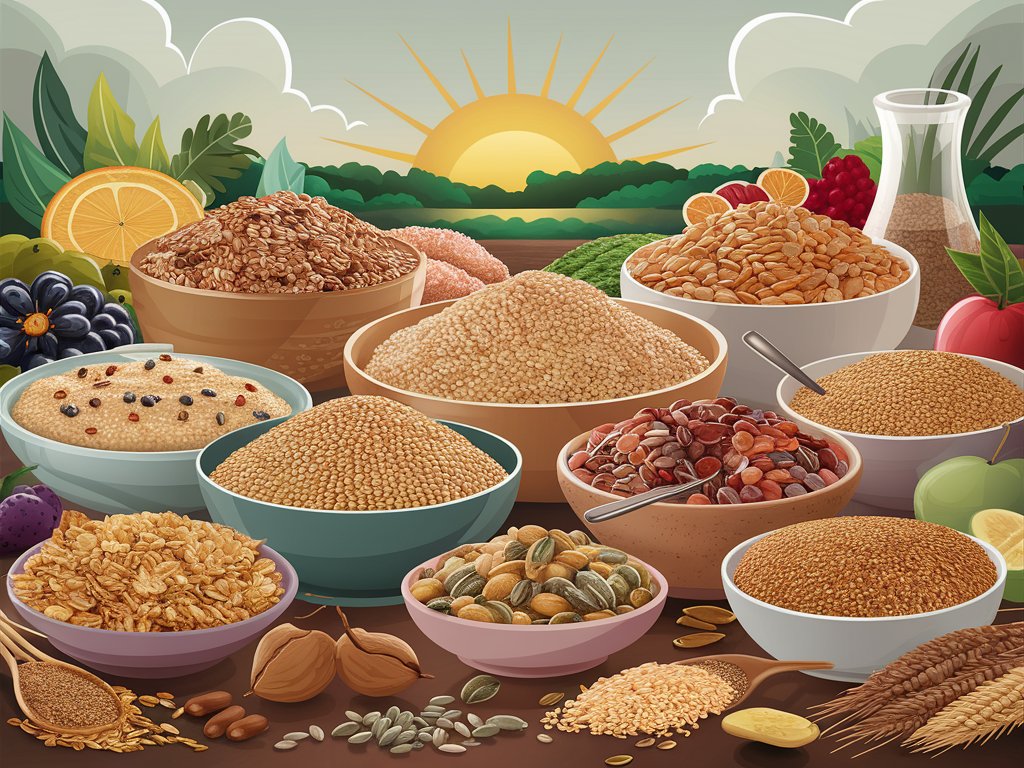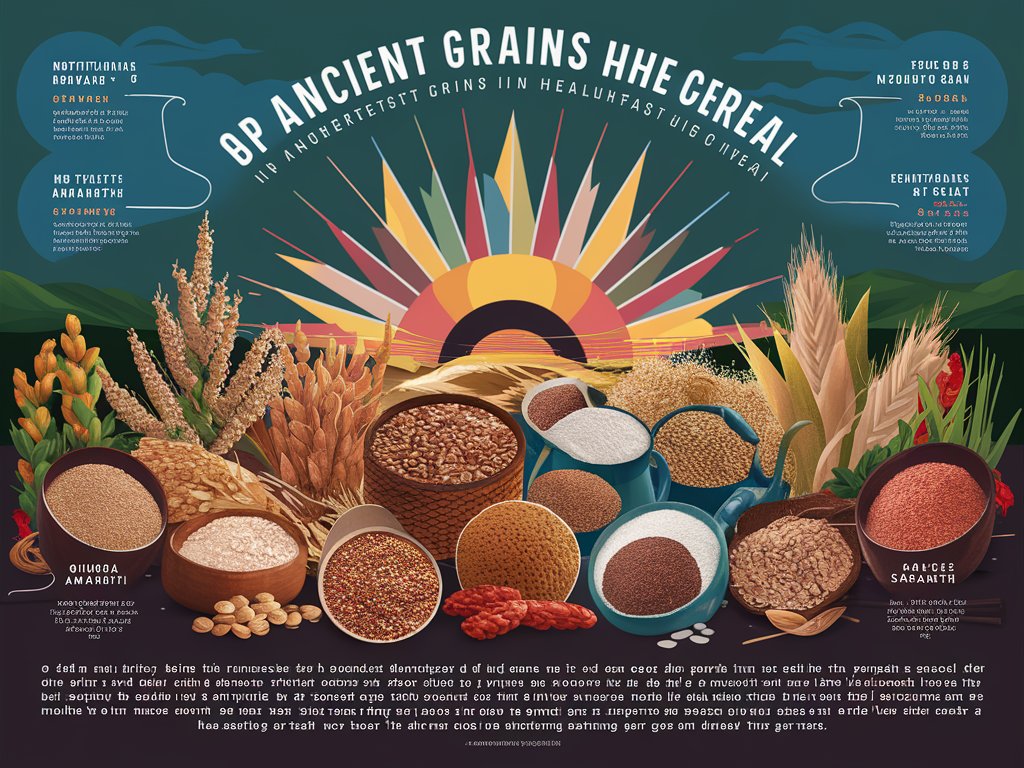In the bustling world of breakfast options, sugary cereals often reign supreme, particularly for children. But the tides are turning! Health-conscious consumers are increasingly seeking out nutritious alternatives that offer a delicious start to the day. Enter the realm of ancient grains in healthy cereal nature’s nutritional powerhouses making a triumphant return to our breakfast bowls.
The ancient grains in healthy cereals within the United States. We’ll explore:
- What are ancient grains?
- Nutritional benefits of ancient grains
- Popular Ancient Grains in Healthy Cereal (US)
- How to choose an ancient grain cereal
- Delicious recipe ideas with ancient grains
Ancient Grains in Healthy Cereal: A Timeless Legacy
Ancient Grains in Healthy Cereal are a diverse group of cereal crops cultivated for centuries, often predating modern wheat varieties. These grains remained largely unchanged from their natural state, offering a unique nutritional profile compared to their refined counterparts.
Here’s what sets them apart:
- Higher Nutrient Content: Ancient grains are often packed with protein, fiber, vitamins, and minerals, making them a more well-rounded breakfast choice.
- Rich in Antioxidants: These grains boast higher levels of antioxidants, which protect your cells from damage.
- Potential Health Benefits: Studies suggest ancient grains may contribute to improved heart health, blood sugar control, and digestive health.
- Gluten-Free Options: Several ancient grains are naturally gluten-free, catering to individuals with celiac disease or gluten sensitivity.
Benefits of Ancient Grains in Healthy Cereal
Let’s delve deeper into the specific nutritional benefits offered by ancient grains:
- Fiber: Ancient grains are high in fiber, promoting digestive health, aiding in weight management, and potentially reducing the risk of heart disease.
- Protein: Certain ancient grains, like quinoa and amaranth, are complete proteins, containing all nine essential amino acids your body needs.
- Vitamins and Minerals: Ancient grains are a good source of vitamins and minerals like iron, magnesium, phosphorus, and B vitamins, crucial for various bodily functions.
- Antioxidants: As mentioned earlier, these grains are rich in antioxidants that combat free radicals and may lower the risk of chronic diseases.
Also Read: Dana Chang Obituary: A Tribute to a Life Well Lived
Ancient Grains in Healthy Cereal: US Cereal Aisles
The US cereal market is witnessing a surge in ancient grain options. Here are some popular ancient grains making waves:
- Quinoa: This protein-rich grain from South America is naturally gluten-free and boasts a complete amino acid profile. Its nutty flavor lends itself well to various cereal blends.
- Amaranth: Another gluten-free powerhouse, amaranth is a tiny grain packed with protein, fiber, and iron. Its earthy taste adds a unique dimension to breakfast cereals.
- Oats: A classic breakfast staple, oats are a good source of fiber and beta-glucan, a type of soluble fiber beneficial for heart health.
- Spelt: An ancient relative of modern wheat, spelt offers a slightly nutty flavor and provides a good source of fiber and protein.
- Sorghum: This gluten-free grain is gaining traction for its high fiber content and mild, slightly sweet flavor.
- Teff: This tiny Ethiopian grain is a good source of calcium and iron, making it a nutritious addition to cereal blends.
Remember: While Ancient Grains in Healthy Cereal offer a wealth of benefits, some may require longer cooking times than traditional cereals. Opt for pre-cooked or quick-cooking options if time is a constraint.
Choosing the Right Ancient Grains in Healthy Cereal: A Consumer’s Guide
With the abundance of ancient grain cereals in the US market, selecting the right one can be overwhelming. Here are some key factors to consider:
- Grain Blend: Look for cereals that combine various ancient grains to maximize the nutritional benefits.
- Sugar Content: Opt for cereals with lower sugar content, ideally less than 5 grams per serving. Added sugars can significantly negate the health benefits of whole grains.
- Fiber Content: Choose cereals with at least 3 grams of fiber per serving to promote digestive health and satiety.
- Protein Content: Consider cereals with a higher protein content, especially if you’re looking for a more filling breakfast option.
- Ingredient List: Look for cereals with whole grains listed as the first few ingredients and avoid cereals with artificial colors, flavors, or preservatives.
- Certifications: Consider certifications like USDA Organic or Non-GMO Project Verified if these aspects are important to you.
Bonus Tip: Don’t be afraid to experiment! Mix and match different ancient grain cereals to create your own personalized blend. Adding nuts, seeds, and dried fruits can further enhance the flavor and nutritional profile.
Inner Chef: Delicious Recipe Ideas with Ancient Grains
Ancient grains aren’t limited to just cereals! Here are some inspiring recipe ideas to incorporate these nutritional powerhouses into your diet:
- Ancient Grain Breakfast Bowl: Combine cooked quinoa, amaranth, or oats with chopped nuts, seeds, and fresh fruits like berries or sliced bananas. Drizzle with a touch of honey, maple syrup, or yogurt for a touch of sweetness.
- Ancient Grain Salad: Prepare a salad base with your favorite leafy greens and vegetables. Toss in cooked farro, sorghum, or teff for a hearty and nutritious addition. Add grilled chicken or tofu for a complete protein source. Dress with a light vinaigrette for a refreshing lunch or side dish.
- Ancient Grain Stuffed Peppers: Bell peppers are a great vessel for a flavorful stuffing. Cook quinoa or brown rice and mix with chopped vegetables, spices, and lean ground meat or lentils. Stuff the mixture into bell peppers and bake until tender.
- Ancient Grain Burgers: Move over, beef! Mash cooked quinoa or black rice with chopped vegetables, herbs, and spices. Form into patties and pan-fry or bake for delicious and nutritious vegetarian burgers.
- Ancient Grain Porridge: For a warm and comforting breakfast, simmer milk or plant-based milk with rolled oats, chopped nuts, and a touch of cinnamon. Add a dollop of nut butter for extra protein and flavor.
- Ancient Grain Pilaf: This versatile dish can be a side dish or a main course. Sauté chopped onions and vegetables, then add rinsed quinoa or bulgur wheat. Pour in vegetable broth and simmer until the grains are cooked and fluffy. Season with herbs and spices like turmeric or cumin for extra flavor.
These are just a few ideas to get you started. With their versatility and unique flavors, ancient grains can be incorporated into countless dishes, adding a healthy and delicious twist to your meals.
The Final Grain: Ancient Grains in Healthy Cereal
Incorporating ancient grains into your diet, particularly in the form of healthy cereals, is a smart way to boost your nutrient intake and fuel your body for the day. With their impressive nutritional profile and growing variety in the US market, ancient grains offer a compelling alternative to traditional breakfast options. So, next time you’re in the cereal aisle, consider giving these time-tested grains a chance. Your taste buds and your body will thank you!




